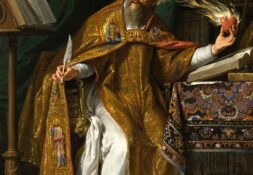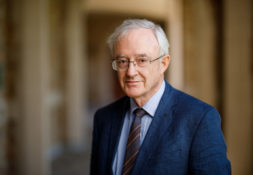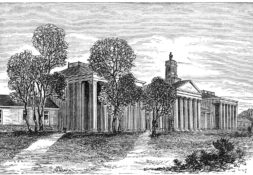“A landscape can sing about God / a body about Spirit.” Dag Hammarskjöld
Lake of the Clouds in the Porcupine Mountains Wilderness State Park of Michigan proclaims a hymn of praise to God and about God. Virgin forest, predominantly of maple and hemlock, covers the valley of the Big Carp River and ridgetops around it as far as the eye can see. It is the largest tract of old growth hardwood forest and of hemlocks in the Great Lakes region and perhaps of North America. Atop the ridge of the North Woods in the late summer, beholding the placid blue lake hundreds of feet below with the silent forest of green extending miles into the distance and ages into the past, the human spirit is aware of the Holy Spirit, the Lord and giver of life. The Holy Spirit’s viriditas—or greening power—gives life to all things and makes all things new. There one experiences the breath-filled wonder of transcendent beauty.
 The final words of The Great Gatsby express a shadow of this encounter: “man must have held his breath in the presence of this continent, compelled into an aesthetic contemplation he neither understood nor desired, face to face for the last time in history with something commensurate to his capacity for wonder.”
The final words of The Great Gatsby express a shadow of this encounter: “man must have held his breath in the presence of this continent, compelled into an aesthetic contemplation he neither understood nor desired, face to face for the last time in history with something commensurate to his capacity for wonder.”
For the wise, this wonder about the natural world leads beyond a scientific or mythical vision to the Creator who fashions all things in divine Wisdom. “Now if out of joy in their beauty they thought them gods, let them know how far more excellent is the Lord than these; for the original source of beauty fashioned them. Or if they were struck by their might and energy, let them realize from these things how much more powerful is the one who made them” (Wisdom 13: 3-4). With eyes properly focused, all of creation is transparent to the divine. St. Bonaventure describes creation as a carmen Dei, a song or poem of God. The faithful have ears attuned to hear this wondrous melody. The world is sacramental; it is a sign that points to the Creator.
For the person of faith, the waterscape and landscape of Lake of the Clouds and the virgin forest are illuminated from within with the divine presence. Creation is not divine, but the transcendent God is immanent in everything, not in any material way, but by his power, presence, and essence as the cause of being of that thing itself. Everything that is comes to be in and through the Word of God. Beauty is the splendor and radiance of being. Just as some organisms are bioluminescent, in that they can generate a cool, biological light—fireflies, glowworms, certain fungi, or marine algae (dinoflagellates) among others—all creatures from the standpoint of being—or ontology—are ontoluminescent. Being is aglow with the divine presence. Delighting in this splendor of being, our spirit lifts from the ground in freedom, joy, wonder, and peace and is led into the glory of God.
Beauty draws us out of ourselves and towards union and communion. The beauty of the Lake of the Clouds draws the observer to union with it. C. S. Lewis keenly observed in The Weight of Glory that when we encounter beauty, “[w]e want something else which can hardly be put into words—to be united with the beauty we see, to pass into it, to receive it into ourselves, to bathe in it, to become part of it.” I once sent a picture of a flower to a friend who responded that she wanted to be the red and yellow of the flower. The beauty of a landscape ultimately draws us into communion with God, the source of Beauty.
Just as the Lake of the Clouds sings about God and draws us into communion with him, the human body sings about Spirit. We can recognize the Spirit of God from our encounter with the bodily presence of another. But here, we must be aware of a false vision that corrupts the pure bodily desire for union into lust. Sin perverts our encounter with beauty. Our sinful desires distort our vision of the luminosity of another’s body. Instead of drawing us to God, we possess it for ourselves and imprison it in our selfish chambers of darkness and isolation. Our sin veils our own splendor and darkens our being. Our disordered encounter with others darkens our vision to receive the beauty of another. We witness this in the Marcan Gospel account of King Herod’s birthday banquet where Salome, the daughter of Herod’s wife and half-niece Herodias and his half-brother Philip, performed a dance that so delighted the king.
The eyes of Herod and the guests gazed upon this young sensuous woman with lust, imprisoning the luminescence of her beauty in their own dark hearts. Instead of rising to God, they sink into themselves. With every veil Salome enticingly removed to reveal more of her body’s luminosity, Herod and the guests veiled her body with a dark, impenetrable cover which absorbed her true splendor. Salome was covered, as was the beautiful analogue to Helen of Troy in Tolstoy’s War and Peace—Ellen. “But Ellen seemed coated with a lacquer left by thousands of eyes that had glanced over her body.” Don’t we know this lacquer? Don’t we feel it applied to us by the lustful gaze of others? Don’t we know this lacquer as we apply it to those upon whom we lustfully gaze? It is the basis for a billion dollar pornography industry, men’s magazines, and swimsuit issues. Those women—beautiful by worldly standards—shapely, proportional, integral—lacking nothing—will be coated in lacquer from the gazes of thousands upon thousands of men.
In sin, we darken our splendor; we make ourselves and others ugly. We lose our integrity in our moral self-alienation. Herod and Salome perverted beauty. Instead of leading one into the glory of God and thus into communion with one another, Salome distorted her beauty to ensnare Herod and to behead John the Baptist. Herod distorted his own beauty by ordering the beheading of John, the dark fruit of lusting after Salome’s beauty.
How do we re-order our vision to see and relate properly to beauty? Our redemption is the Cross which von Balthasar describes as the “summit of beauty.” The Cross judges the beauty of the world and finds all worldly aesthetics of our finite and sinful order inadequate. The self-abnegation of conforming ourselves to the Crucified One opens our eyes to see the splendor of being and to praise and glorify God. The Spirit dominates and permeates us. We are no longer merely natural men and women (psychikos anthropos) living according to the flesh but spiritual men and women (pneumatikos anthropos) whose bodies are under the guidance and power of the Spirit. As such we glow with a radiant luminosity and rejoice in each other, not for selfish or sinful motives but in divine delight in what is as gift and pointer to God.
Tomorrow is the feast of the Nativity of the Blessed Virgin Mary, the most beautiful of our race for she was without any stain of sin. She is compared to the beauty of the landscape of Mount Carmel. “Like the crocus it shall bloom abundantly, and rejoice with joyful song. The glory of Lebanon will be given to it, the splendor of Carmel and Sharon; They will see the glory of the LORD, the splendor of our God” (Isaiah 35:1-2). Her very being sings to God and of the Spirit.
In the Mass setting for Our Lady entitled “Mother of Fairest Love”, the Preface of the Eucharistic Prayer speaks of Mary’s beauty:
“Beauty was hers at her conception, free from all stain of sin; resplendent in the glory of grace. Beauty was hers in her virginal motherhood: she brought forth her Son, the radiance of your glory . . . Beauty was hers in the Passion of her Son: . . . in her meekness she shared the suffering of the Lamb of God, her Son . . . Beauty was hers in the Resurrection of Christ: she reigns with him in glory, the sharer now in his triumph.”
The refulgence of the statute of Our Lady atop the Golden Dome reflects the luminosity of the woman who was conceived without the stain of original sin and was assumed body and soul into heaven, the first fruits of the Resurrection of her Son who proclaimed on earth, “Let your light shine before all so that others will see your good works and glorify your Father in heaven” (Matt 5:16). As children of Mary at Notre Dame, we are called to make the opening prayer of the Marian Mass setting our own, “Grant that we may turn from the ugliness of sin and love only the beauty that comes from your Spirit.”
Father Terry Ehrman, CSC, is the assistant director of the Center for eology, Science, and Human Flourishing and a concurrent instructor in the eology Department at the University of Notre Dame.






Leave a Reply